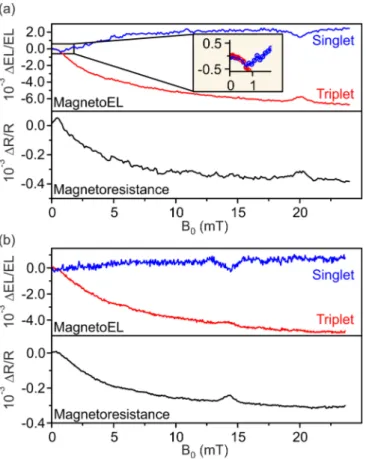Visualizing the radical-pair mechanism of molecular magnetic field effects by magnetic resonance induced electrofluorescence to electrophosphorescence interconversion
Hermann Kraus,
1Sebastian Bange,
1Felix Frunder,
1Ullrich Scherf,
2Christoph Boehme,
3and John M. Lupton
1,*1
Institut für Experimentelle und Angewandte Physik, Universität Regensburg, Universitätsstrasse 31, 93053 Regensburg, Germany
2
Macromolecular Chemistry Group, Chemistry Department and IfP, Bergische Universität Wuppertal, Gauss-Strasse 20, 42097 Wuppertal, Germany
3
Department of Physics and Astronomy, University of Utah, Salt Lake City, Utah 84112, USA (Received 13 February 2017; revised manuscript received 25 April 2017; published 14 June 2017) We probe the interconversion of spin permutation symmetry of weakly bound electron-hole carrier pairs in an organic light-emitting diode by monitoring the changes in yield of recombinant species—singlet and triplet excitons—through fluorescence and phosphorescence, respectively. Spin mixing occurs by spin precession in local hyperfine fields and is suppressed by an external magnetic field, leading to an anticorrelation of fluorescence and phosphorescence yield, which follows the same functionality as magnetoresistance. A resonant radio-frequency field reverses this effect, enhancing spin mixing to raise the phosphorescence and lower the fluorescence. The experiment offers a direct simultaneous optical probe of the two interconverting spin states in the radical-pair mechanism, which features prominently in models of biological magnetoception.
DOI: 10.1103/PhysRevB.95.241201
Many molecular reactions exhibit strong magnetic-field effects at room temperature with regard to a specific reaction yield [1]. A physical picture put forward to explain some of the observations, the radical-pair mechanism [2], involves the modification by an external magnetic field of the precession of the spins of positive and negative charges in local hyperfine fields. Since such a radical—or electron-hole—pair is Coulom- bically bound, it can ultimately recombine, with the rate of recombination depending on the spin permutation symmetry of the pair. Many examples of the influence of magnetic fields on reaction yields based on such underlying pair processes have been reported, with measurable magnetic-field effects on scales as small as a few microtesla [3]. Such processes have also been invoked to explain the magnetoceptive abilities of some birds [3]. While the precise chemical and physiological origin of this ability remains subject to debate, the sensitivity of birds to magnetic fields was recently underlined by the demonstration of an influence of ambient electromagnetic noise on navigational ability [4]. The fact that extremely weak oscillatory fields of nanotesla amplitude [4] disrupt magnetoception suggests that spin-dependent reaction yields are influenced by very long spin-coherence times [5], possibly of 0.1 ms duration [6]. Although much of the research interest in spin-dependent radical-pair processes stems from such biological or model synthetic chemical phenomena, a crucial limitation of investigations is that it is only the reaction yield which is measured rather than the permutation symmetry of the spin pair [7–10]. Analogous spin-pair processes can also arise in the solid state, and have been invoked to explain magnetic resonance phenomena and magnetic-field effects in the conductivity of amorphous silicon [11] and molecular organic semiconductor films [12–18]. Such measurements are, in principle, sensitive down to the single-charge level. We recently reported a direct probe of electronic spin coherence in thin films of organic semiconductors incorporated in an organic
*


